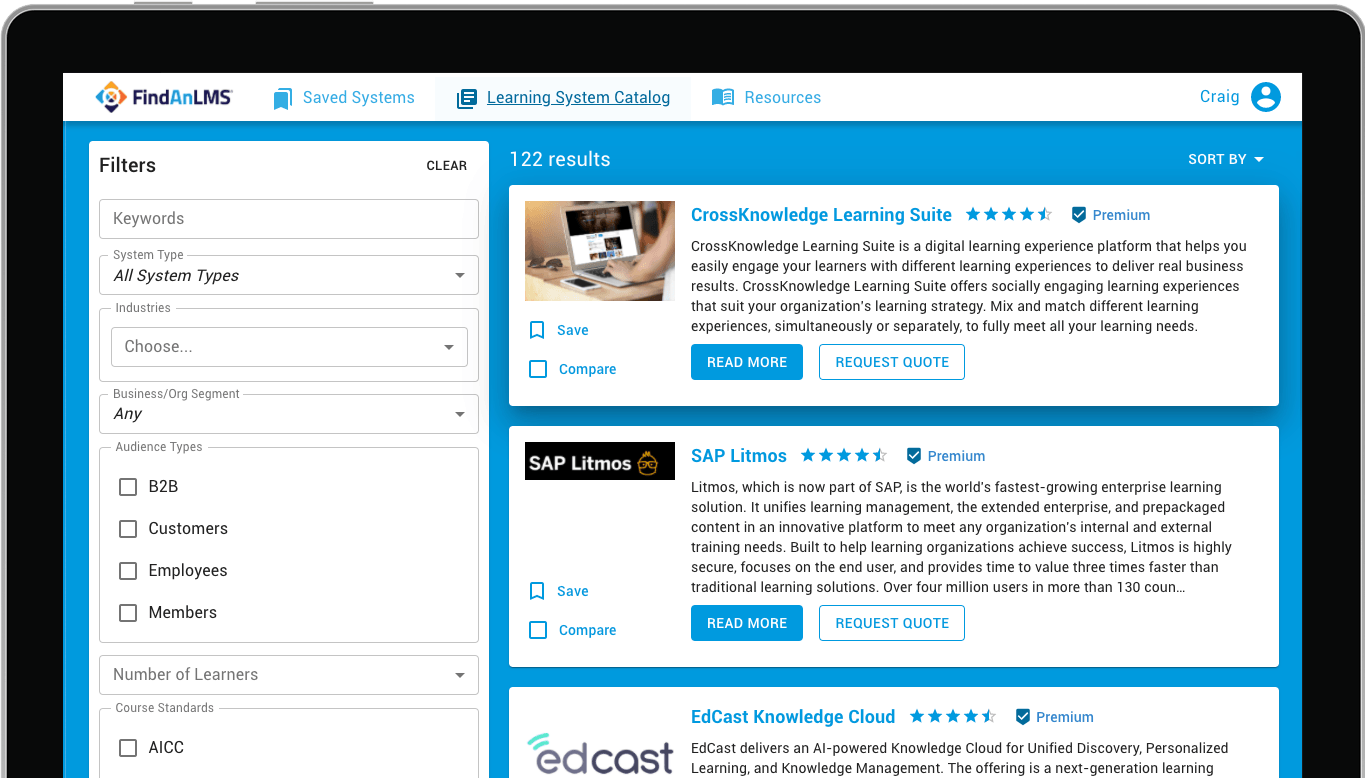If your organization invests in employee training and development, you probably want your learners to get as much out of it as possible. Furthermore, you need to prove that your organization’s elearning strategy is a success to stakeholders. These twin goals require the collection of robust data to demonstrate the value of your online learning and training program.
Nearly every LMS (or learning management system) collects data to some degree, but some learning analytics are more valuable than others. Sadly, management frequently cannot distinguish between worthless data and powerful analytics, leading to a significant waste of time and money while learners feel neglected. That won’t help in the development of an organization-wide learning culture at all.
If you want to make data analytics a competitive advantage for your organization, it’s best to turn to an education expert. Craig Weiss is broadly recognized as one of the top three elearning experts in the world. He has firsthand experience with over a thousand LMS software solutions and created FindAnLMS.com as a free platform to help users find the perfect training software for their needs. Weiss argues that “the LMS is only as good as the metrics,” demonstrating just how important LMS analytics are to a successful elearning program.
This article will cover how to transform analytics into actionable insights you can use to enhance training for your learners. It begins with a brief discussion of how analytics can improve learning before delving into which metrics are the most important to training success. Next, it explores how to make data more powerful through integrations with other sources of learner data. Finally, we’ll look at how Weiss and FindAnLMS.com can help you find an analytics platform. Let’s get started!
How can metrics and learning data support training?
The purpose of analytics is to quantify what learners are getting from your elearning initiative. Learning and development managers can leverage LMS data to uncover fresh insights into how users are engaging with content. This information can then be applied to drive improved decision-making, boost learner performance, and ultimately propel an organization toward success.
For example, your LMS might offer machine learning AI capabilities to automatically enroll learners in courses based on their training performance. A struggling learner will get the support they need to catch up while admins won’t need to laboriously analyze transcripts to sign them up manually. You can also show users how they’re performing in real time so they don’t have to wait for a formal learning assessment to discover areas of potential improvement.
Of course, training data isn’t limited to performance on tests and quizzes. You can also track learner engagement, providing insight into what content users find helpful and what might be modified to make it more relevant to your team. A great LMS will facilitate two-way communication in multiple ways to ensure every learner has their voice heard.
Similarly, data could help your e-commerce efforts. For instance, you could review your customer education materials to determine what partners are spending the most time with and offer more content in those fields. If you have content that isn’t performing as well, analytics provide the evidence you need to change it or even scrap it for something that would generate more revenue.
What LMS analytics should I look for in a learning management system?
Many people assume that learning data begins and ends with completion rates, believing that completed courses mean retained knowledge and successful training. Nothing could be further from the truth. If you’re using completion rates to measure performance, you’re telling your learners that the bare minimum effort is good enough. You don’t care about their personal or professional development and don’t regard employee learning or training as a worthwhile endeavor. If management makes content completion mandatory, completion rates tell you even less.
Similarly, overall training duration can be very misleading as learners learn at their own pace. A quick study might complete training in half an hour while another learner takes twice as much time to digest the same content. It can be tempting to see this as valuable data, but it doesn’t matter as long as both learners grasp the information presented.
Instead, Weiss recommends looking for a platform that tells a data story so you can draw insights without false conclusions or staring at spreadsheets. Here are five specific analytics to look for when choosing an LMS:
- Data Segmentation
Data segmentation refers to the ability to analyze metrics by course, department, cohort, individual, or project as needed. A great LMS will let you do so effortlessly, while others use it as an excuse to upsell you. Consider Absorb LMS as an example. You get analytics with Absorb out of the box, but they don’t have all of the analytics tools you might expect. The vendor offers outstanding tools, but you have to pay extra and add Absorb Analyze to your package to get them. Add-ons like this are common in the elearning industry, so watch your budget.
- Sharable Reports
The value of data analysis reaches its apex when all stakeholders can access the analytics, but giving every department access to the data quickly becomes chaotic. A great platform will offer versatile reporting tools such as configurable reports and templates and automatically send them wherever they need to go. Everyone can benefit from analytics without needing access to the LMS itself.
- Voluntary Usage Rates
If your organization offers customer or partner training, your LMS should show you who is taking advantage of the content you provide. This is also a handy feature for employees who need compliance training content or recertification since admins can see who is lagging and intervene before too much time has elapsed.
- Trend Lines Over Time
Your employee development content isn’t static but evolving as the needs of your learners change. Your LMS needs to track how these changes affect the development of your team, and the best way to do that is by tracking key performance indicators over time. A great LMS will let you pick which metrics to track and how to present the data to optimize your use of it.
- What Content Are Learners Looking For?
Your learners will tell you what content they’re most interested in by spending more time on it and choosing it over materials that don’t fit their needs. Your education platform should let you include a table of contents (or TOC in elearning circles) in every course and track how often users click on each section, letting you tell at a glance what is supporting learning and professional development and what isn’t.
Gain additional insights and LMS data from a third-party application
Many organizations use an application such as Salesforce to help them track their data, but management shouldn’t have to switch between multiple sources of learning data for insights. If your platform supports SCORM or xAPI protocols, you can link it to services like Salesforce to get more out of your analytics. If your LMS solution doesn’t include this feature, you may still be able to connect through out-of-the-box support or a service such as Salesforce Connect.
The important thing is to keep all of your analytics in one place instead of having to switch between software applications to see everything. Learning is more effective when efficient.
Find an LMS to support your organization’s training goals today with FindAnLMS.com
The right predictive learning analytics will improve your employee development efforts by streamlining training for everybody involved. Choosing an LMS is the first step toward this goal, but it isn’t as easy as reading a few learning management system reviews and calling it a day.
Fortunately, Craig Weiss has you covered. When you create a free account on FindAnLMS.com, you’ll get immediate access to elearning insights straight from the expert himself, exclusive ratings of top LMS vendors, and a snapshot of what each vendor offers in terms of analytics. You can also compare up to four vendors head-to-head and look up contact information, all in one convenient location. If you’re trying to pick an LMS without using FindAnLMS.com, you’re doing it wrong.

